Abstract
Chainsaw operation is associated with several hazards, including exposure to wood dust, a risk factor which requires serious attention due to health impacts such as respiratory disease. This study aims to investigate the effect of saw chain type and wood species on the mass concentration of airborne wood dust during chainsaw cross-cutting operations. Real-time inhalable and respirable dust measurements in the breathing zone of the chainsaw operator were carried out using a desktop aerosol monitor. Three types of cutter shape (semi chisel, full chisel, and chamfer chisel) and four types of wood species (oak, beech, spruce, and fir) were used in the experiments. The split-plot ANOVA results showed that both respirable and inhalable mass concentrations of wood dust were affected exclusively by wood species. No statistically significant differences were found among particular levels of cutter shape. The highest average mass concentrations of airborne dust were generated by the combination of oak wood and a full chisel cutter.
1. Introduction
The methods and technologies of wood harvesting are significantly limited by terrain conditions, which are relatively demanding in the forests of the Slovak Republic. For that reason, the tree-length (TL) method is the most used wood harvesting method in Slovakia. In motor-manual TL harvesting, trees are felled and delimbed with a chainsaw, with skidding conducted using tractors, skidders, or animals. According to [1], the proportion of chainsaw use is approximately 85% in terms of total wood harvesting in Slovakia.
Chainsaws are a source of many significant hazards (e.g., mechanical, thermal, noise, vibration, physical load, exhaust fume, and airborne wood dust hazards). A significant body of research exists regarding the exposure of chainsaw operators to noise [2,3,4], vibrations [5,6,7], and physical load [8,9,10]. Several studies have been performed to determine the concentration of carbon monoxide [11,12] and exhaust fumes [13] within the breathing zone of chainsaw operators and explore simultaneous exposure to exhaust fumes and noise [14].
Exposure to wood dust has been associated with several health problems—it may cause symptoms in the eyes, nose, respiratory system, and skin. The International Agency for Research on Cancer (IARC) has classified wood dust as carcinogenic, particularly for cancers of the nasal cavities and paranasal sinuses, mainly as a result of exposure to hardwoods; however, there may also be a much smaller excess risk of sinonasal cancer associated with softwoods [15]. Further, wood dust exposure is a risk factor for the development of asthma [16,17,18], chronic bronchitis [19], rhino-conjunctivitis [20], chronic impairment of lung function [21], and contact dermatitis [22,23,24]. The behavior, deposition, and fate of wood particles after their entry into the human respiratory system are determined by the size and chemical composition of the particle. Standard EN 481 [25] defines the conventions for particle size fractions (inhalable, thoracic, and respirable) that are used to assess possible health effects resulting from inhalation of airborne particles. Conventions are stated in terms of mass fraction, and it is often used to specify instruments that can be used to sample airborne particles for the purpose of measuring concentrations corresponding to defined fractions [26]. In Slovakia, occupational exposure limits for wood dust have been established depending on the type of wood. For hardwood (beech, oak) dust, a binding 8 h time weighted average (TWA) limit value of 2 mg·m−3 (3 mg·m−3 until 17 January 2023) was set by European Union Directive 2017/2398 [27]. For wood dust, which is classified as a solid aerosol with a predominantly irritating effect, limit values are determined as follows: exotic woods (1 mg·m−3) and other woods (8 mg·m−3). The limit values mentioned above do not take into account potential allergic effects and the content of microorganisms in wood dust.
Standard measurement methods for wood dust exposure assessment are based on gravimetric techniques. A complementary approach to the conventional filter-based gravimetric methods uses direct-reading aerosol monitors [28,29,30,31,32,33]. Depending on the operating principle used, they can be classed into the following main groups: piezoelectric mass monitors, tapered element oscillating microbalance monitors, beta mass monitors, and photometers. Direct-reading aerosol monitors are generally useful for relative assessment of aerosol concentration variations rather than for measuring absolute aerosol concentration. Their main advantage is that they give an almost instantaneous measure of airborne particle concentration, thereby considerably reducing the time and effort associated with standard gravimetric methods [34]. In the case of photometers, the main disadvantage is that their response is dependent upon particle size, shape, and refractive index. For that reason, photometers usually require on-site calibration. In contrast with, for example, circular saws, planers, or sanders, there currently is no specific standardized procedure for measurement of the dust concentration produced by chainsaws.
Factors thought to influence the exposure of chainsaw operators to airborne wood dust have been explored in several studies [35,36,37,38,39]. Horvat et al. [35] carried out a comparison between measured mass concentration of respirable particles and total dust for sample pairs collected during the felling of dead standing fir-trees in relation to maximum permissible concentrations for fir-wood. In another study, Horvat et al. [36] reported significant difference between mass concentrations of oak wood respirable particles in winter during the final cut and on thinning in summer, while the difference between mass concentrations of total dust was not so apparent. Marchi et al. [37] found that exposure to wood dust varied widely with different silvicultural treatments, while no significant difference was found for different types of chainsaw fuel. The study [38] demonstrated that cutting chain selection and proper chain preparation are crucial for achieving high productivity and reducing health risk. Dimou et al. [39] showed that the concentration of inhalable dust is in inverse proportion to the increase in breast height diameter, implying that larger trees generated lower dust amounts. Together, these studies outline that the exposure of chainsaw operators to airborne wood dust was usually lower than current occupational exposure limits. Nevertheless, several authors [37,38,39] highlight that occupational exposure limits are based on epidemiological studies from the furniture industry and thus do not reflect the special conditions prevailing in outdoor workplaces.
To the best of our knowledge, no previous studies have been undertaken to investigate the influence of saw chain type and wood species on wood dust emission from chainsaws. The aim of this study is to explore the effect of cutter shape and wood species on airborne wood dust concentration during chainsaw cross-cutting operations.
2. Materials and Methods
2.1. Experimental Setup and Design
Experimental measurements were carried out in a test room that fulfills the criteria specified in the EN 50632-1 standard [40]. The layout of the experimental setup is shown in Figure 1. In order to investigate the influence of the aforementioned factors on dust emission formation, cross-cutting experiments were carried out using a factory-fresh cordless chainsaw (MSA 220 C, Andreas Stihl AG & Co. KG, Weiblingen, Germany) with a lithium-ion battery (Stihl AP 300 S, Andreas Stihl AG & Co. KG, Weiblingen, Germany). The battery was charged using a high-speed charger (Stihl AL 500, Andreas Stihl AG & Co. KG, Weiblingen, Germany). The chainsaw was equipped with a 35 cm length guide bar (Stihl Rollomatic E, Andreas Stihl AG & Co. KG, Weiblingen, Germany) as specified by the machine’s manufacturer. A single individual, experienced in the use of the chainsaw, performed the cross-cutting operations.
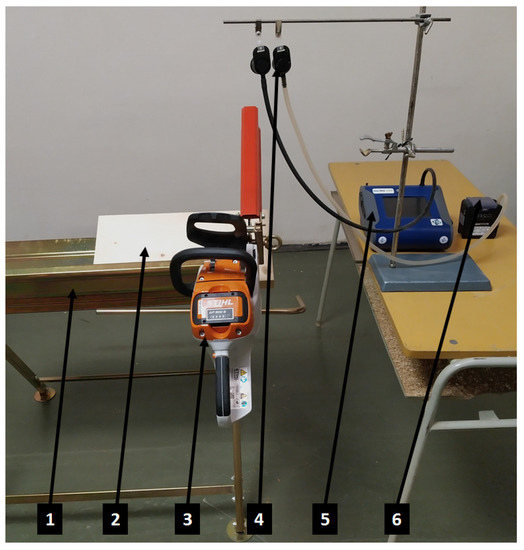
Figure 1.
Layout of the experimental setup: 1—sawhorse with chainsaw holder, 2—test specimen, 3—chainsaw, 4—IOM sampler, 5—aerosol monitor, 6—pump.
The experiment was designed as a two-factor split-plot experiment with a randomized complete block design involving three levels of cutter shape and four levels of wood species. Cutter shape was considered as a hard-to-change factor because it was time-consuming to change. Each treatment was replicated 10 times so that the total number of runs was 120. The order of runs was randomized in each block.
2.2. Saw Chains
The saw chains under study (see Figure 2) were a full chisel chain (Stihl Picco Super 3, Andreas Stihl AG & Co. KG, Weiblingen, Germany), semi-chisel chain (Stihl Picco Micro 3, Andreas Stihl AG & Co. KG, Weiblingen, Germany), and a chamfer chisel chain (Stihl Picco Duro, Andreas Stihl AG & Co. KG, Weiblingen, Germany). To avoid the condition of the saw chain having any effect on the dust measurements, only chains originally sharpened by the manufacturer were used for each test cycle (16 runs). The saw chains were lubricated with chain oil (Stihl BioPlus, Andreas Stihl AG & Co. KG, Weiblingen, Germany) and tensioned according to manufacturer’s recommendations.
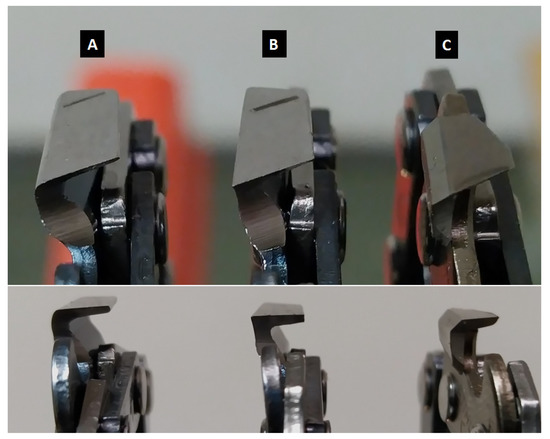
Figure 2.
The different shapes of saw chain cutters used in the experiments: A—semi chisel, B—full chisel, C—chamfer chisel.
All chains used in the experiment had the following parameters: pitch—3/8” P (9.32 mm), drive link gauge—1.6 mm, number of drive links—50, chain arrangement—standard. According to the manufacturer’s specification, the maximum chain speed was 23.30 m·s−1.
2.3. Test Specimens
The tree species under study were oak (Quercus petraea (Matt.) Liebl.), beech (Fagus sylvatica L.), spruce (Picea Abies (L.) H. Karst), and fir (Abies alba Mill.). Test specimens in the form of planks 500 mm × 250 mm × 50 mm in dimension were conditioned to a final moisture content of 12% before experimentation. A sawhorse with a chainsaw holder (Magg 120009, PHT a.s., Prague, Czech Republic) was used to clamp the test specimens.
2.4. Airborne Dust Concentration Measurement
Inhalable and respirable wood dust mass concentrations were measured using a desktop aerosol monitor (DustTrak 8533 DRX, TSI Inc., Shoreview, MN, USA). The real-time monitor measured and recorded wood dust mass concentration every second. Before each sampling event, the zero offset calibration was performed with a HEPA filter, as recommended by the manufacturer. A plastic IOM sampler (IOM Multidust sampler, SKC Inc., Eighty-four, PA, USA) was connected to monitor the inlet using conductive tubing. Fixed-point sampling was employed, and the sampler was positioned within the breathing zone of the operator. Each sampling event lasted 5 min. The average air flow speed at the sampling point was measured using an anemometer (Testo 415, Testo SE & Co., Titisee-Neustadt, Germany) and ranged from 0.02 m·s−1 to 0.08 m·s−1. Simultaneously, dust sampling was performed using an IOM dual-fraction sampler with a sampling pump (AirChek Essential, SKC Inc., Eighty-four, PA, USA). The IOM sampler was equipped with a 25 mm glass fiber filter (GF 50, Hahnemühle GmbH, Dassel, Germany) and polyurethane foam insert (IOM MultiDust respirable foam disc, SKC Inc., Eighty-four, PA, USA). Filters were dried in a desiccator at least 12 h before/after they were weighed. Prior to sampling, the pump was calibrated to 2 L·min−1 using a differential pressure flowmeter (Chek-mate 375-0550, SKC Inc., Eighty-four, PA, USA). After sampling, the flow rate of the pump was measured again to confirm a constant airflow rate in the range of ±5%. Gravimetric analysis of the collected samples was performed using an analytical balance (XA 110, Radwag, Radom, Poland). Temperature and relative ambient humidity were monitored using a microclimatic conditions monitor (Testo 480, Testo SE & Co., Titisee-Neustadt, Germany). All tests were conducted at an ambient temperature of 20 °C ± 1 °C and at a relative ambient humidity of 36% ± 1%. The background concentration was monitored using an optical particle size spectrometer (model OPS 3330, TSI Inc., Shoreview, MN, USA) and was always below 0.1 mg·m−3 in the test room before the cross-cutting experiments were started.
2.5. Feed Force Monitoring System
In order to ensure a consistent cross-cutting operation, monitoring of feed force was performed using a glove-based measurement system (CERAA Glove; Asseco CEIT a.s., Žilina, Slovakia). Figure 3 shows the details of the components set up to monitor feed force during the cross-cutting process. The connection between the data box and the tablet (Huawei MediaPad M2 10.0; Huawei Technologies Co, Ltd., Shenzhen, China) with the installed CERAA software application was realized via Bluetooth technology. A feed force of 30 N ± 2 N was applied to the rear handle of chainsaw.
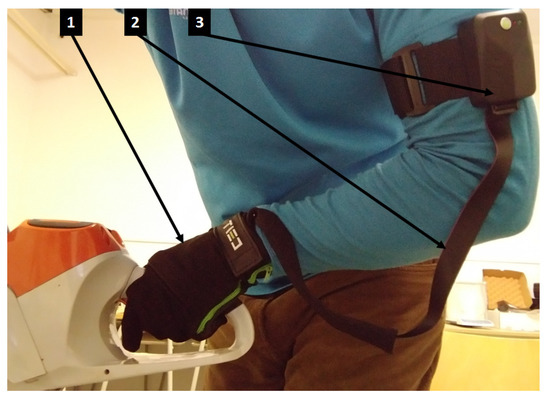
Figure 3.
Feed force monitoring system: 1—glove with pressure sensors, 2—data cable, 3—data box/Bluetooth transmitter.
2.6. Data Analysis
TrakPro software (version 4.6.1.0, TSI Inc., Shoreview, MN, USA) was used for data post-processing. Data normality was tested using the Shapiro–Wilk test. The split-plot analysis of variance (ANOVA) test was used to assess the effect of cutter shape and wood species on airborne wood dust mass concentration. Post hoc analysis was conducted with Tukey’s HSD test. The level of confidence was set to 95%, and a p value < 0.05 was chosen to indicate statistical significance. All statistical analyses were performed using a Microsoft Excel freeware add-on called Real Statistics.
3. Results
3.1. Temporal Variations in Mass Concentration
Figure 4 shows an example of the temporal variations in aerosol monitor response according to time for generated spruce dust during cross-cutting with a full chisel chain. Almost the same pattern of temporal variations in the mass concentration of inhalable/respirable dust was observed for all treatments.
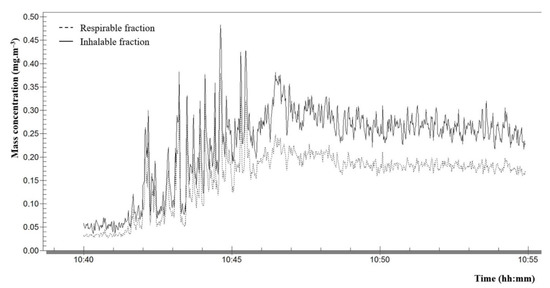
Figure 4.
Temporal variations in the mass concentration of inhalable/respirable dust while cross-cutting spruce wood with a full chisel chain. Cross-cutting started at 10:41 and ended at 10:46.
3.2. Calibration Factors
A calibration factor is defined as the number that the monitor concentration is multiplied by so that it agrees with the reference measurement [29]. The DustTrak DRX monitor (TSI Inc., Shoreview, MN, USA) is factory calibrated to respirable fractions of standard Arizona test dust. The aerosol monitor has two calibration factors. The photometric calibration factor (PCF) accounts for the photometric response difference between standard test dust and the aerosol being measured. The size calibration factor (SCF) accounts for the differences in aerodynamic size and optical response [41].
Custom calibration factors were developed by comparing side-by-side gravimetric and photometric samples. Samples were collected during wood cross-cutting with a semi-chisel chain. Table 1 illustrates paired data resulting from wood dust mass concentration measurements using the gravimetric method and a real-time aerosol monitor. The aerosol monitor greatly underestimated the respirable fraction and inhalable fraction for all the wood dusts tested.

Table 1.
Summary of calibration factors for different wood dust types using the gravimetric method compared to photometric monitoring data (arithmetic mean ± standard deviation, n = 3).
3.3. Respirable Mass Concentration
The influence of cutter shape and type of wood on the respirable fraction of the mass concentration of airborne dust particles emitted by the chainsaw is shown in Figure 5.
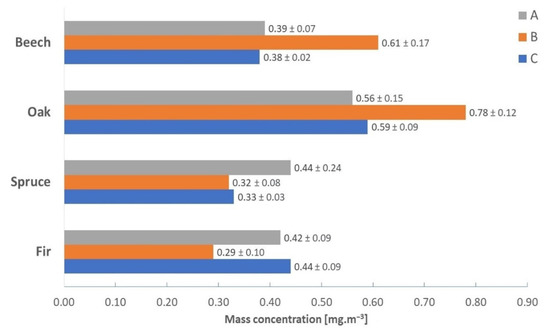
Figure 5.
Effect of cutter shape (A—semi chisel, B—full chisel, C—chamfer chisel) and wood species on respirable mass concentration (arithmetic mean ± standard deviation, n = 10).
The highest average mass concentration of 0.78 mg·m−3 was measured when cutting oak wood with a full chisel cutter. On the other hand, the minimum average mass concentration of 0.29 mg·m−3 was measured when cutting fir wood with a full chisel cutter. The split-plot ANOVA indicated that the respirable mass concentration of wood dust was only significantly affected by wood species (see Table 2). Interaction between the examined variables had a statistically significant effect on respirable mass concentration.

Table 2.
Results of split-plot ANOVA on respirable mass concentration data.
Post hoc analysis using Tukey’s HSD test showed that there is a significant difference between the examined wood species, with only two exceptions (see Table 3). No differences between fir and beech (p = 0.068; MF = 0.382; MB = 0.459) and fir and spruce (p = 0.93; MS = 0.363) were observed.

Table 3.
Results of Tukey’s HSD post hoc analysis of respirable mass concentration data.
3.4. Inhalable Mass Concentration
The influence of cutter shape and type of wood on the inhalable fraction of the mass concentration of airborne dust particles emitted by the chainsaw is shown in Figure 6.
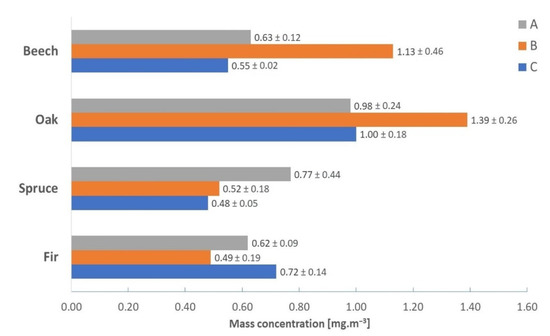
Figure 6.
Effect of cutter shape (A—semi chisel, B—full chisel, C—chamfer chisel) and wood species on inhalable mass concentration (arithmetic mean ± standard deviation, n = 10).
The highest average mass concentration of 1.39 mg·m−3 was observed when cutting oak wood with a full chisel cutter. On the other hand, the minimum average mass concentration of 0.48 mg·m−3 was measured with a chamfer chisel chain when cutting spruce wood. The split-plot ANOVA indicated that the inhalable mass concentration of wood dust was only significantly affected by wood species (see Table 4). The interaction between examined variables had a statistically significant effect on inhalable mass concentration.

Table 4.
Results of split-plot ANOVA for inhalable mass concentration data.
Post hoc analysis using Tukey’s HSD test showed that there is a significant difference between examined wood species, with only one exception (see Table 5). No difference between spruce and fir (p = 0.987; MS = 0.589; MF = 0.609) was observed.

Table 5.
Results of Tukey’s HSD post hoc analysis of inhalable mass concentration data.
4. Discussion
As pointed out in the introduction to this paper, there is currently no specific standardized procedure for measuring the dust concentration produced by chainsaws. In this study, real-time inhalable and respirable dust measurements in the breathing zone of chainsaw operators were used to investigate the influence of cutter shape and wood species on airborne wood dust concentration during chainsaw cross-cutting operations. The findings from this study suggest that wood species have an effect on the production of wood dust in chainsaw cutting. Overall, for both fractions, hardwoods (angiosperms) generated higher dust concentrations than softwoods (gymnosperms). A possible explanation for this might be that differences in the mechanical properties of hardwoods and softwoods lead to dissimilarity in the number and size of wood dust particles emitted during cross-cutting with a chainsaw. Cross-cutting is a mixed cell-shattering and chip-forming process. In general, the harder the wood, the more tightly bound the cells; therefore, more shattering occurs with hardwoods, resulting in more dust [15]. Contrary to expectations, this study did not find a statistically significant effect in relation to cutter shape and airborne wood dust concentration. The reason for this is not clear but may have something to do with different wear rates for different types of cutter shape. Wojcik and Kalinowski [42] investigated the effect of saw chain cutter type on the speed of blunting. They found that there are significant differences in the speed of blunting between chisel and semi-chisel types of saw chain. It is a well-known fact that saw chain dulling is accompanied by an increase in emitted wood dust.
Comparing the results of airborne wood dust concentration evaluation from different experimental setups and field measurements reported in the literature is very difficult. However, the results of our study are consistent with results reported by several authors [35,36,37,39,43] in the sense that hardwoods generated higher dust concentrations than softwoods. Horvat et al. evaluated the daily exposure of cutters to respirable particles and total dust during cutting and processing of dead standing fir-trees [35], oakwood [36], and beech trees [43]. They reported the highest mean values of mass concentration of total dust and respirable fraction for oak wood, followed by fir wood and beech wood. Marchi et al. [37] evaluated exposures to inhalable wood dust among forest workers during motor-manual felling and processing of different tree species. They recorded the highest average exposure to wood dust for clear-cut coppice in relation to silvicultural treatment. In coppicing, mainly hardwood species were cut (Quercus cerris L., Ostrya carpinifolia L.). The concentrations of inhalable hardwood dust from Fagus sylvatica and Quercus petrae, as well as softwood dust from Pinus brutia stands, were examined by Dimou et al. [39]. They reported the highest average value of dust mass concentration for oak wood, followed by pine wood and a mixed oak–beech stand.
Several limitations to this study need to be considered. First, we did not determine size and photometric calibration factors for the aerosol monitor. The DustTrak DRX monitor combines photometry with single particle sizing for mass measurement. The manufacturer of the aerosol monitor offers two calibration methods. The primary goal of standard calibration is to obtain a SCF for the aerosol of interest. The standard calibration process does not require external gravimetric filter sampling. It is based on measurement of aerosol size distribution with and without a PM 2.5 impactor included in the accessory kit. With a calibrated SCF, the aerosol monitor will assign each sampled particle to the right size fraction and then calculate mass concentration based on the particle counts in the different size fractions. No calibration is made to the photometric component of the mass measurement. The advanced calibration method is employed to yield high size-segregated mass concentration accuracy for single size fractions. It involves two gravimetric measurements to obtain a PCF and SCF. The two gravimetric measurements can be performed in sequence or in parallel, depending on gravimetric sampling device availability. Even though we have tried to develop custom calibration factors, the weighing errors for gravimetric samples were too great to provide meaningful results. The reason for this is probably a combination of several factors. Furthermore, samples were only collected during wood cross-cutting with a semi-chisel chain. However, the intention of this study was to investigate if there is any difference between different settings rather than to determine real occupational exposure to airborne wood dust. For this reason, it was sufficient to obtain relative mass concentration values. Second, a minor limitation of this study can be considered in connection with the use of a safety enclosure. The safety enclosure, as a part of the sawhorse, reduced the amount of airborne dust wood that was emitted to the breathing zone of the operator.
5. Conclusions
This paper investigated the influence of saw chain type and wood species on the mass concentration of airborne wood dust during cross-cutting. Based on experimental results, the following findings are concluded for this specific case:
- Airborne dust mass concentration was only affected by wood species.
- Oak wood generated the highest average dust mass concentration, followed by beech wood, fir wood, and spruce wood. A statistically significant difference was found between examined wood species, with only three exceptions.
- Surprisingly, no statistically significant differences were found when the full chisel was compared to the semi-chisel and chamfer chisel in terms of generated dust mass concentration.
Further research should be conducted to investigate the effect of saw chain type on the mass concentration of airborne wood dust during cross-cutting. In future investigation, factors such as the wear rate of the cutter, the speed of cutter blunting, chain arrangement, and chain tensioning should be considered. Further study taking the above-mentioned variables into account will need to be undertaken.
Author Contributions
Conceptualization, M.D. and J.S.; methodology, M.D. and R.H.; investigation, M.D., M.K. and R.H.; statistical analysis, T.H.; writing—original draft preparation, M.D. and M.K.; writing—review and editing, J.S.; visualization, M.D.; supervision, R.H. All authors have read and agreed to the published version of the manuscript.
Funding
This research was funded by the Scientific Grant Agency of the Ministry of Education, Science, Research and Sports of the Slovak Republic and the Slovak Academy of Sciences, grant number 1/0019/19.
Data Availability Statement
The data that support the findings of this study are available from the corresponding author, J.S., upon reasonable request.
Acknowledgments
The paper is based on work performed under research contract VEGA 1/0019/19 “Predictive models of workplace atmosphere contamination by solid aerosol during mechanical wood processing”of the Scientific Grant Agency of the Ministry of Education, Science, Research and Sports of the Slovak Republic and the Slovak Academy of Sciences, whose support is gratefully acknowledged.
Conflicts of Interest
The authors declare no conflict of interest.
References
- Ministry of Agriculture and Rural Development of the Slovak Republic. Report on Forestry in the Slovak Republic for 2020—Green Report. Available online: https://www.mpsr.sk/?navID=123 (accessed on 8 November 2022).
- Neri, F.; Laschi, A.; Foderi, C.; Fabiano, F.; Bertuzzi, L.; Marchi, E. Determining Noise and Vibration Exposure in Conifer Cross-Cutting Operations by Using Li-Ion Batteries and Electric Chainsaws. Forests 2018, 9, 501. [Google Scholar] [CrossRef]
- Rukat, W.; Jakubek, B.; Barczewski, R.; Wróbel, M. The Influence of the Direction of Wood Cutting on the Vibration and Noise of Chainsaws. Teh. Vjesn. 2020, 27, 1879–1886. [Google Scholar] [CrossRef]
- Huber, M.; Hoffmann, S.; Brieger, F.; Hartsch, F.; Jaeger, D.; Sauter, U.H. Vibration and Noise Exposure during Pre-Commercial Thinning Operations: What Are the Ergonomic Benefits of the Latest Generation Professional-Grade Battery-Powered Chainsaws? Forests 2021, 12, 1120. [Google Scholar] [CrossRef]
- Iftime, M.D.; Dumitrascu, A.-E.; Ciobanu, V.D. Chainsaw Operators’ Exposure to Occupational Risk Factors and Incidence of Professional Diseases Specific to the Forestry Field. Int. J. Occup. Saf. Ergon. 2022, 28, 8–19. [Google Scholar] [CrossRef]
- Kováč, J.; Krilek, J.; Dado, M.; Beňo, P. Investigating the Influence of Design Factors on Noise and Vibrations in the Case of Chainsaws for Forestry Work. FME Trans. 2018, 46, 513–519. [Google Scholar] [CrossRef]
- Landekić, M.; Bačić, M.; Pandur, Z.; Šušnjar, M. Vibration Levels of Used Chainsaws. Forests 2020, 11, 249. [Google Scholar] [CrossRef]
- Arman, Z.; Nikooy, M.; Tsioras, P.A.; Heidari, M.; Majnounian, B. Physiological Workload Evaluation by Means of Heart Rate Monitoring during Motor-Manual Clearcutting Operations. Int. J. For. Eng. 2021, 32, 91–102. [Google Scholar] [CrossRef]
- Cheţa, M.; Marcu, M.V.; Borz, S.A. Workload, Exposure to Noise, and Risk of Musculoskeletal Disorders: A Case Study of Motor-Manual Tree Feeling and Processing in Poplar Clear Cuts. Forests 2018, 9, 300. [Google Scholar] [CrossRef]
- Grzywiński, W.; Turowski, R.; Jelonek, T.; Tomczak, A. Physiological Workload of Workers Employed during Motor-Manual Timber Harvesting in Young Alder Stands in Different Seasons. Int. J. Occup. Med. Environ. Health 2022, 35, 437–447. [Google Scholar] [CrossRef]
- Leszczyński, K. The Concentration of Carbon Monoxide in the Breathing Areas of Workers during Logging Operations at the Motor-Manual Level. Int. J. Occup. Med. Environ. Health 2014, 27, 821–829. [Google Scholar] [CrossRef]
- Hooper, B.; Parker, R.; Todoroki, C. Exploring Chainsaw Operator Occupational Exposure to Carbon Monoxide in Forestry. J. Occup. Environ. Hyg. 2017, 14, D1–D12. [Google Scholar] [CrossRef] [PubMed]
- Neri, F.; Foderi, C.; Laschi, A.; Fabiano, F.; Cambi, M.; Sciarra, G.; Aprea, M.C.; Cenni, A.; Marchi, E. Determining Exhaust Fumes Exposure in Chainsaw Operations. Environ. Pollut. 2016, 218, 1162–1169. [Google Scholar] [CrossRef]
- Schwarz, M.; Salva, J.; Dado, M.; Vanek, M.; Borošová, D. Combined Exposure to Noise and Exhaust Fumes During Chainsaw Operation. Akustika 2019, 31, 64–72. [Google Scholar]
- IARC Working Group on the Evaluation of Carcinogenic Risks to Humans. Arsenic, Metals, Fibres and Dusts; International Agency for Research on Cancer: Lyon, France, 2012; ISBN 978-92-832-1320-8. [Google Scholar]
- Wiggans, R.E.; Evans, G.; Fishwick, D.; Barber, C.M. Asthma in Furniture and Wood Processing Workers: A Systematic Review. Occup. Med. 2016, 66, 193–201. [Google Scholar] [CrossRef]
- Pérez-Ríos, M.; Ruano-Ravina, A.; Etminan, M.; Takkouche, B. A Meta-Analysis on Wood Dust Exposure and Risk of Asthma. Allergy 2010, 65, 467–473. [Google Scholar] [CrossRef]
- Schlünssen, V.; Sigsgaard, T.; Raulf-Heimsoth, M.; Kespohl, S. Workplace Exposure to Wood Dust and the Prevalence of Wood-Specific Sensitization. Allergol. Select 2018, 2, 101–110. [Google Scholar] [CrossRef]
- Jacobsen, G.; Schaumburg, I.; Sigsgaard, T.; Schlünssen, V. Wood Dust Exposure Levels and Respiratory Symptoms 6 Years Apart: An Observational Intervention Study Within the Danish Furniture Industry. Ann. Work Expo. Health 2021, 65, 1029–1039. [Google Scholar] [CrossRef] [PubMed]
- Jacobsen, G.; Schaumburg, I.; Sigsgaard, T.; Schlunssen, V. Non-Malignant Respiratory Diseases and Occupational Exposure to Wood Dust. Part I. Fresh Wood and Mixed Wood Industry. Ann. Agric. Environ. Med. 2010, 17, 15–28. [Google Scholar] [PubMed]
- Baran, S.; Swietlik, K.; Teul, I. Lung Function: Occupational Exposure to Wood Dust. Eur. J. Med. Res. 2009, 14, 14–17. [Google Scholar] [CrossRef]
- Bonamonte, D.; Romita, P.; Filoni, A.; Angelini, G.; Foti, C. Airborne Contact Dermatitis. Open Dermatol. J. 2020, 14, 31–37. [Google Scholar] [CrossRef]
- Estlander, T.; Jolanki, R.; Alanko, K.; Kanerva, L. Occupational Allergic Contact Dermatitis Caused by Wood Dusts. Contact Dermat. 2001, 44, 213–217. [Google Scholar] [CrossRef]
- Chu, C.; Marks, J.G.; Flamm, A. Occupational Contact Dermatitis: Common Occupational Allergens. Dermatol. Clin. 2020, 38, 339–349. [Google Scholar] [CrossRef]
- EN 481:1993; Workplace Atmospheres—Size Fraction Definitions for Measurement of Airborne Particles. The European Committee for Standardisation: Brussels, Belgium, 1993.
- Campopiano, A.; Basili, F.; Angelosanto, F.; Cannizzaro, A.; Olori, A.; Ramires, D.; Iannò, A.; Angelici, L. Field Comparison of Two Inhalable Samplers Used in Italy to Measure the Wood Dust Exposure. Int. J. Occup. Environ. Health 2016, 22, 159–166. [Google Scholar] [CrossRef] [PubMed]
- Directive (EU) 2017/2398 of the European Parliament and of the Council of 12 December 2017 Amending Directive 2004/37/EC on the Protection of Workers from the Risks Related to Exposure to Carcinogens or Mutagens at Work (Text with EEA Relevance). 2017. Available online: http://data.europa.eu/eli/dir/2017/2398/oj/eng (accessed on 8 November 2022).
- Thorpe, A.; Walsh, P.T. Performance Testing of Three Portable, Direct-Reading Dust Monitors. Ann. Occup. Hyg. 2002, 46, 197–207. [Google Scholar] [CrossRef][Green Version]
- Thorpe, A. Assessment of Personal Direct-Reading Dust Monitors for the Measurement of Airborne Inhalable Dust. Ann. Occup. Hyg. 2007, 51, 97–112. [Google Scholar] [CrossRef][Green Version]
- Thorpe, A.; Walsh, P.T. Direct-Reading Inhalable Dust Monitoring--an Assessment of Current Measurement Methods. Ann. Occup. Hyg. 2013, 57, 824–841. [Google Scholar] [CrossRef]
- Patts, J.R.; Tuchman, D.P.; Rubinstein, E.N.; Cauda, E.G.; Cecala, A.B. Performance Comparison of Real-Time Light Scattering Dust Monitors Across Dust Types and Humidity Levels. Min. Metall. Explor. 2019, 36, 741–749. [Google Scholar] [CrossRef]
- Halterman, A.; Sousan, S.; Peters, T.M. Comparison of Respirable Mass Concentrations Measured by a Personal Dust Monitor and a Personal DataRAM to Gravimetric Measurements. Ann. Work. Expo. Health 2018, 62, 62–71. [Google Scholar] [CrossRef]
- Čavlović, A.O.; Bešlić, I. Application of Photometry in Determining the Dust Mass Concentration of Hardwoods. Wood Res. 2021, 66, 678–688. [Google Scholar] [CrossRef]
- Dado, M.; Mikusova, L.; Hnilica, R.; Očkajova, A. Calibration of Photometer-Based Direct-Reading Aerosol Monitors. MM Sci. J. 2017, 2069–2072. [Google Scholar] [CrossRef]
- Horvat, D.; Čavlović, A.; Zečić, Ž.; Šušnjar, M.; Bešlić, I.; Madunić-Zečić, V. Research of Fir-Wood Dust Concentration in the Working Environment of Cutters. Croat. J. For. Eng. 2017, 26, 85–90. [Google Scholar]
- Horvat, D.; Kos, Ž.; Zečić, Ž.; Jazbec, A.; Šušnjar, M.; Očkajová, A. Tree Cutters’ Exposure to Oakwood Dust—A Case Study from Croatia. Die Bodenkult. 2007, 58, 59–65. [Google Scholar]
- Marchi, E.; Neri, F.; Cambi, M.; Laschi, A.; Foderi, C.; Sciarra, G.; Fabiano, F. Analysis of Dust Exposure during Chainsaw Forest Operations. Iforest-Biogeosciences For. 2017, 10, 341. [Google Scholar] [CrossRef]
- Marenče, J.; Mihelič, M.; Poje, A. Influence of Chain Filing, Tree Species and Chain Type on Cross Cutting Efficiency and Health Risk. Forests 2017, 8, 464. [Google Scholar] [CrossRef]
- Dimou, V.; Malesios, C.; Chatzikosti, V. Assessing Chainsaw Operators’ Exposure to Wood Dust during Timber Harvesting. SN Appl. Sci. 2020, 2, 1899. [Google Scholar] [CrossRef]
- EN 50632-1; Electric Motor-Operated Tools. Dust Measurement Procedure. Part 1: General Requirements. The European Committee for Standardization: Brussels, Belgium, 2015.
- ISO 12103-1:2016; Road Vehicles-Test Contaminants for Filter Evaluation-Part 1: Arizona Test Dust. International Organization for Standardization: Geneva, Switzerland, 2016.
- Wójcik, K.; Kalinowski, T. The Speed of Blunting of Saw Chain Cutting Edges during Cross-Cutting. Ann. Wars. Univ. Life Sci. SGGW Agricult. 2018, 71, 51–59. [Google Scholar] [CrossRef]
- Horvat, D.; Kos, A.; Zečić, Ž.; Jazbec, A.; Šušnjar, M. Concentration of Wood Dust in the Working Environment during Felling and Processing of Beech Trees. In Proceedings of the FORMEC 2005—Scientific Cooperation for Forest Technology Improvement, Ljubljana, Slovenija, 26–28 September 2005; Biotechnical Faculty, University of Ljubljana: Ljubljana, Slovenija, 2005; p. 123. [Google Scholar]
Publisher’s Note: MDPI stays neutral with regard to jurisdictional claims in published maps and institutional affiliations. |
© 2022 by the authors. Licensee MDPI, Basel, Switzerland. This article is an open access article distributed under the terms and conditions of the Creative Commons Attribution (CC BY) license (https://creativecommons.org/licenses/by/4.0/).